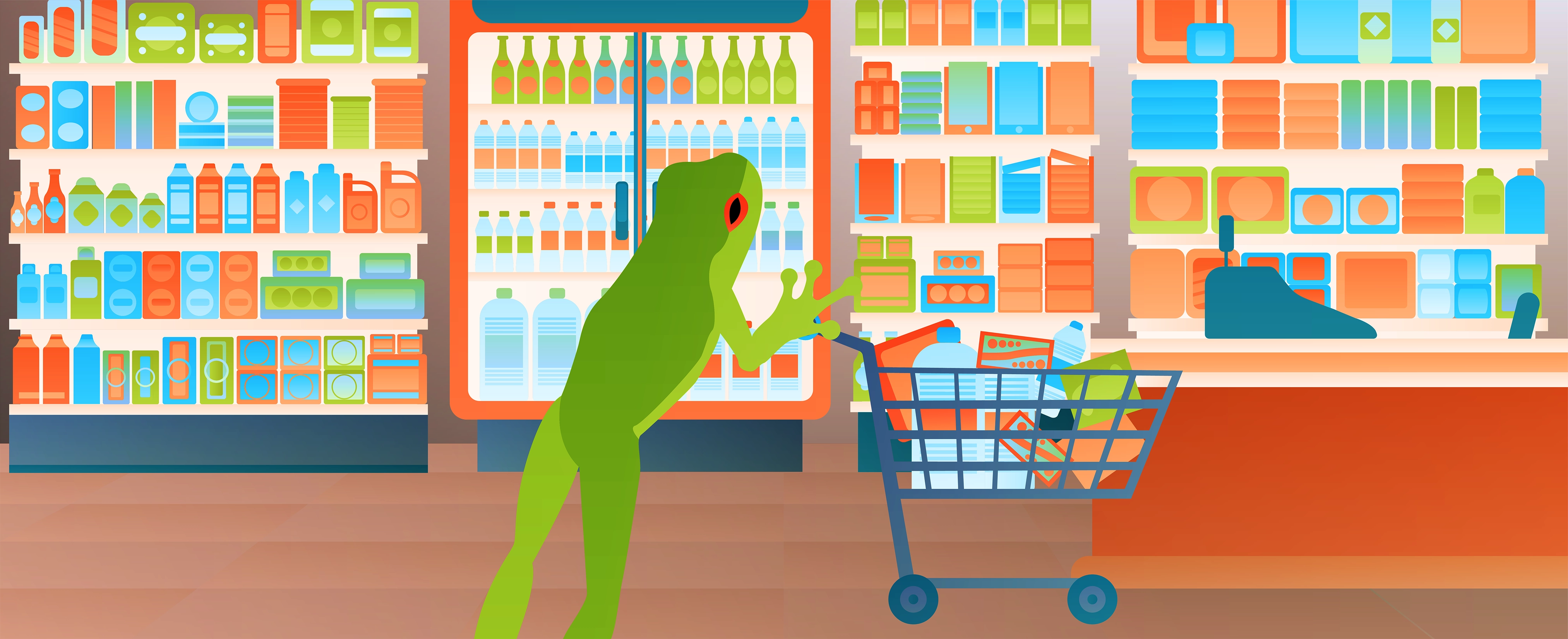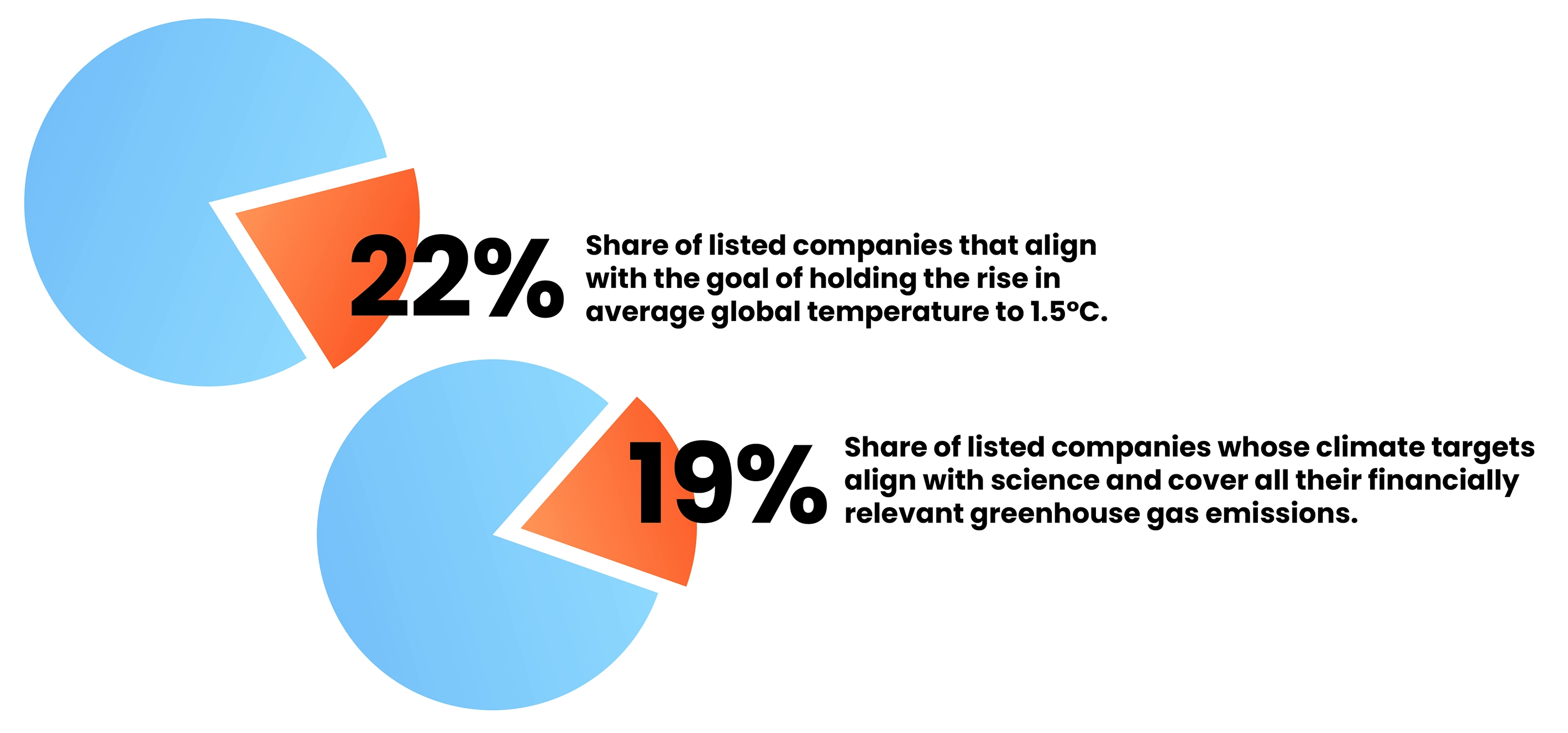On this page…
Areas of Action: Other Consumption
Decarbonizing your consumption overall is a process you can take immediate action on and continue to improve on over time, alongside companies as they shift to sustainable and circular models. This area of personal climate action is like a little mountain of small rocks.
Like fashion, it is an area that is easy to implement, can save you money, and can concurrently address a number of other critical issues including worker rights and slave labour, waste and plastic pollution, health and wellbeing, and water scarcity and pollution if desired.
There are a lot of good reasons to change your purchasing, use and disposal behaviour to help drive systemic change. There is also an opportunity to take a step a back and look at your relationship with consumption per se, reflecting on the fact that you are not a consumer first and foremost, you are an individual with an identity that may be reflected in, but doesn’t depend on your consumption patterns.
There are lots of ways to spend time and money and lots of ways to express yourself that don’t require extractive, polluting consumption.
Opportunities for Change
• Carbon intensive, wasteful, polluting, unethical and high volume consumption.
• Climate friendly, more circular/less wasteful, less polluting, ethical, higher quality, reduced quantity, consumption with cost savings as desired. Increases in non-consumptive and/or low carbon ways of spending our time.
• Agency to influence corporations to deliver low carbon/circular products and services.
Why is this so important?
Household consumption — not including home energy, personal transportation and food — accounts for about a third of your Carbon Footprint.
Although each product or service consumed only accounts for a tiny fraction of your footprint, collectively they have a large impact and collective shifts in consumption can drive systemic change and support companies that are working to address the climate crisis. Many companies are taking action but businesses, like individuals, are not on track yet.
It is also important to keep in mind that although individual footprints are small, Canadian consumption footprints are disproportionately large with the global context and even within the context of industrialized nations2.
Why so urgent?
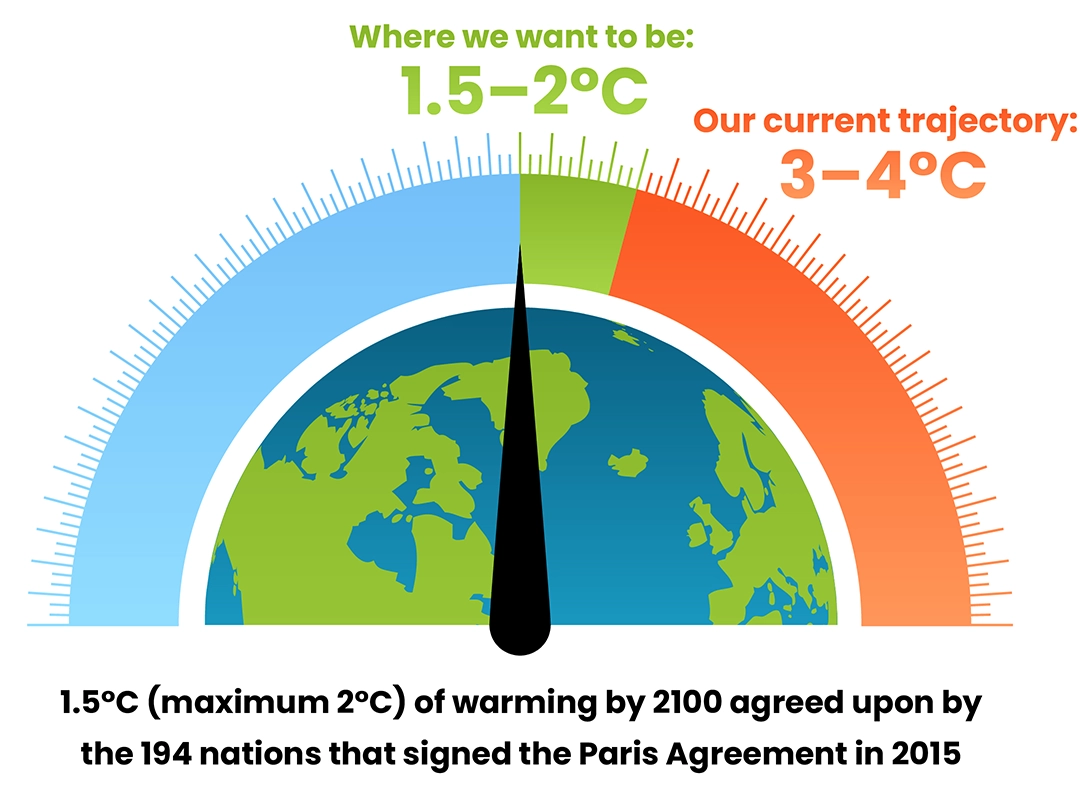
There is a rapidly narrowing window of time to implement existing commitments and raise ambition3. See Why So Urgent?
As per the Paris Agreement and subsequent IPCC modelling and research updates, we need to reduce our emissions by 43% below 2019 levels by 2030 in order to have a good chance of hitting Net Zero emissions by 2050 and avoiding the worst impacts of climate change.
Of course, the Federal government does not target individual consumption per se in its climate action legislation. Our consumption behaviour is on us and on corporations providing goods and services. However, the government implemented legislation that impacts corporate climate action and individual consumption.
For example, they have targeted funds towards low carbon technologies and other low carbon innovations and initiatives — e.g. through the Canada Infrastructure Bank — and have taxed emissions. Currently, they are implementing climate disclosure legislation (as is the US and the EU) (see below). They also have provided some individual incentives towards transitioning to sustainable goods (primarily around durable household goods such as appliances and cars.) And they have legislated against some uses of microplastics and single use plastics (which are made of fossil fuels.)
Overall consumption and shifting behaviour

The best way to reduce your consumption Carbon Footprint is to simply buy less stuff — don’t buy it at all or buy things less frequently or buy quality over quantity — at least until there are circular and low/no carbon options for non-essential goods.

The next best option is to spend your money on lower carbon options wherever possible (different stuff, or more sustainable and/or less wasteful versions of stuff.)

The third best option (though not mutually exclusive to the second one) is to buy stuff from companies that are taking action to address the climate crisis — even if the product or service you want is not low carbon yet.
This last option will become easier in future when we can see which companies are making genuine progress aligned to the 1.5°C goal. In addition to being more conscious about purchasing behaviour, using and disposing of products and services more sustainably can also help to reduce your Carbon Footprint.
It’s ok if you need a little time to shift to a new way of thinking and acting. Get started with good intentions and increase your ambition over time, use tools and strategies to help you remember and don’t feel guilty about specific behaviours you can’t prioritize right now or can’t change immediately or keep forgetting to change (looking at you, re-usable vegetable bags.)
Remember that there is a lot of advertising/marketing and cultural pressure against you making these changes — but also a lot of positive reinforcement on the other side as well.
The easiest way to think about sustainable products is through the principles of a circular economy. I describe this further below.
But before we delve into this further, I think there is value in taking a step back and reflecting on whether it’s true for you — as it is for many people — that activities, experiences, self-development, helping others and participating in your community, and spending time with friends and family are more fulfilling and bring more happiness than things.
If so, there are a ton of low carbon ways to spend time and money that you can feel good about and hopefully use to replace any high carbon discretionary spending.
An individual first and consumer second: Relatively low carbon ways to spend time and money — alone or with friends/family
• Biking, hiking, walking, running
• Spending time at a park (especially with packed snacks or a picnic!)
• Reading a book / participating in a book club / visiting the library
• Watching a movie (but skip the high waste concession options at the theatre if possible)
• Having a drink (coffee/other) with friends
• Sharing a meal (choose low carbon options!)
• Playing games / doing puzzles etc.
• Taking a course / going to school
• Learning / playing an instrument
• Going to the gym / working out
• Having a night out at a sustainable restaurant / hotel / air bnb
• Listening to music / seeing a live music event (but skip any high waste concession options)
• Visiting an art gallery or museum
• Watching TV/streaming service
• Going to church
• Participating in community centre activities
• Playing video games (turn off your computer or console when not in use!)
• Visiting a fair or amusement park (but skip the high waste concessions if possible)
• Volunteering time and/or donating money (except to high-emitting or climate doubting organizations)
Generally — choosing people and experiences over stuff and avoid carbon intensive activities.
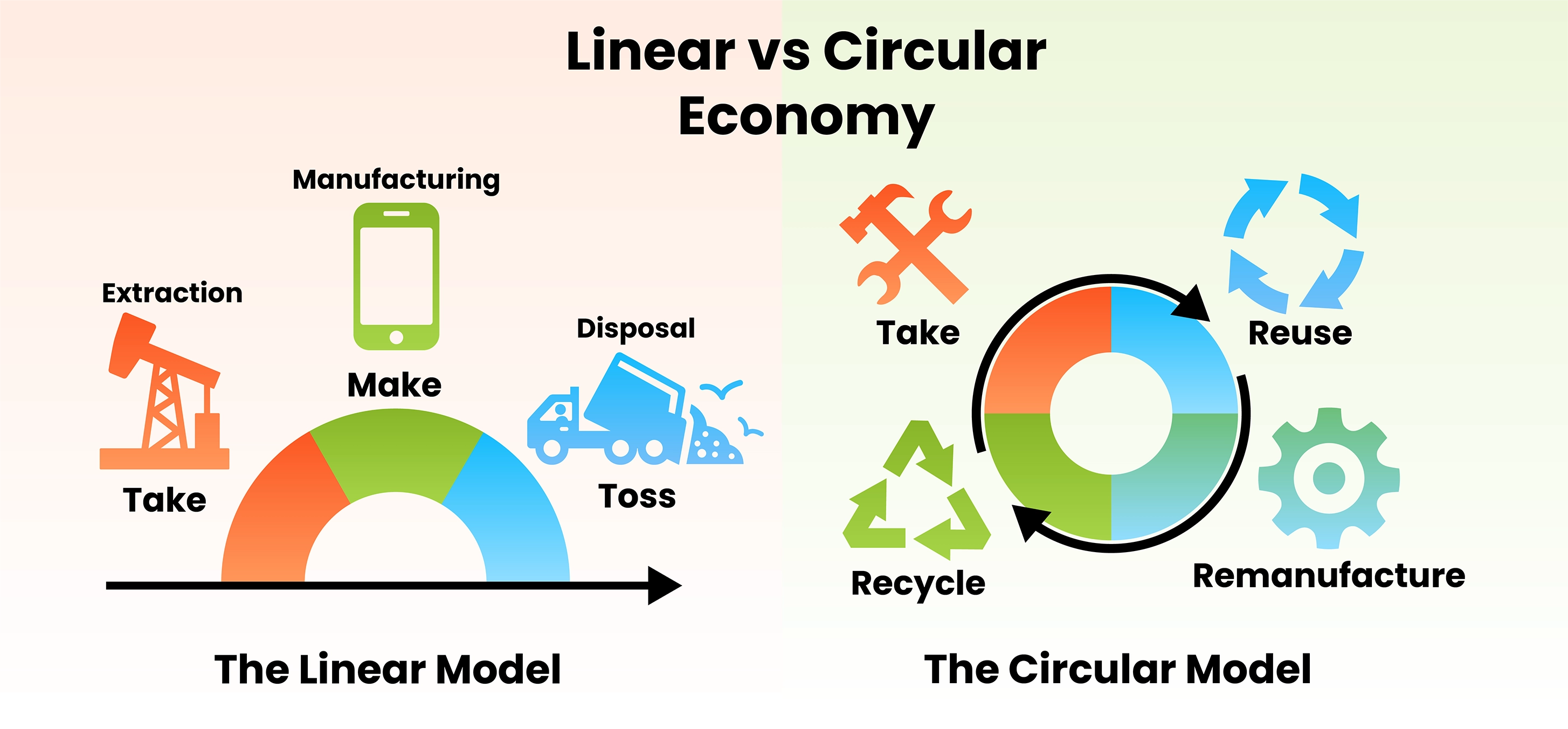
Consider the principles of circularity for consumption of goods before you buy new stuff

Refuse/Reduce
• In our current world of make–use–waste, less is best.
• Think about quality over quantity (E.g. consider supporting locally made over mass produced and shipped from overseas)
• Consider durability over single/short-term use.
• Buy what you need or what you will use a lot and treasure and avoid excess or impulsive buying.
• Avoid plastic and/or excessive packaging where possible. Tell brands and stores that you care about plastic and other waste. Buy in bulk where possible and use zero waste stores. Refuse bags when you shop and bring your own. Opt for glass or wood/paper containers/packaging over plastic where possible.
• Avoid online deliveries if you have the option to buy at a store on a combined trip (e.g. to/from somewhere you are already going.)
• Refuse paper copies of advertising and donation solicitations and use online options instead if you want the communications.
• Buy in bulk (but with a plan to avoid waste if the product is perishable/expires)
• When buying gifts, opt for gift cards unless you know what the person really wants/needs. Consider pooling resources to buy a higher quality, more durable or needed gift. Consider replacing the holiday gift exchanges with another activity or give gift cards (incl. money towards experiences over things)
• For birthday parties, consider using a tool like ECHOage, which allows you to request money towards a larger gift and donate to a cause of the child’s choice at the same time.
• For products that use energy (e.g. electronics), reduce the amount of energy needed by buying efficient products (incl. eg. energy STAR) and cutting the power when not in use!

• Use book or tool sharing libraries or informal sharing systems among friends/family. Create a sharing board or use a neighbourhood site to communicate sharing options. Think beyond books, tools and clothes to rarely used cooking appliances, party décor, camping gear etc. Take stock of your stored stuff and think about what might be shareable and ask around to see what you may be able to borrow before you buy.
• Use carsharing services if you don’t need a car full time or only need an extra car on occasion.
• Consider buying some products in bulk and sharing / splitting the cost with others.

Recycle
• Factor in the recyclability of packaging when choosing products (e.g. avoid options that have mixed plastic and cardboard if difficult to separate — think pasta boxes!)
• Recycle wherever possible (and find out how much your area actually recycles plastic — note that, globally, less than 10% of plastic actually gets recycled!)
• Use sock collection and other recycling programs that may be available in your area (see fashion section for some examples.)
• Properly recycle all electronics, batteries, medicines, hazardous waste
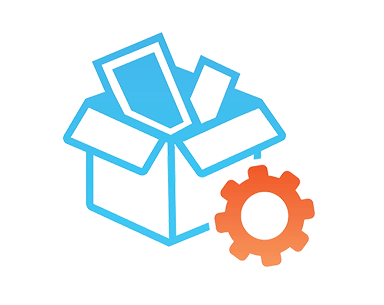
Repair, Maintain and Prolong the life of your stuff
• Buy with durability in mind and plan ahead for bigger purchases if possible (e.g. if upfront cost prevents you from buying higher quality (even though the lifetime cost is the same or less expensive), create a rainy day account for funds used towards bigger purchases, if possible, to overcome that barrier.
• Maintain your car, appliances, clothes, tools etc.
• If you are not handy, ask or hire someone who is to help maintain and repair things
• Prolong the life of your electronics by a year or two (or whatever you can manage) rather than getting the latest and greatest as soon as it is available.

Reuse or Upcycle
• Buy second hand. You are saving items from landfills and can buy quality, ethical items for a great price. There are many online sources of second-hand goods in addition to brick and mortar stores.
• Use rechargeable batteries
• Look into using re-usable containers for refilling e.g. soaps, many foodstuffs)
• Repurpose packaging for storage containers, seedlings etc.
• Refurbish old furniture (or hire someone to)

Donate or Re-commerce
• Avoid throwing things away if someone else can use it and donate it or sell via a consignment shop or an online marketplace.
• Use mattress and other donation programs.
• Donate furniture to designated stores like Habitat for Humanity

Rent
• Use a rental service (either subscription or rent-per-use) for occasionally used items like tools, carpet cleaners, costumes (or buy second hand), fancy clothes etc.
Time can be our biggest enemy as it is often easier to buy new than it is to ask around, shop second hand, repair, find a sustainable option or even dig into our storage spaces in some cases. Choose some areas to form new habits in (and don’t expect yourself to conquer the world in a day) and implement new or improved systems that can facilitate a less wasteful lifestyle can help you shift towards a sustainable, less carbon intensive lifestyle.
If you can avoid buying new, great. If not, when buying new, choose sustainable options and support sustainable companies wherever possible.
Supporting companies that are taking climate action—the big picture
The reason I start with some information about the big picture is that I think it’s important to see that…

Change is happening at a massive, systemic scale

We are nowhere near out of the woods yet because we didn’t start early enough and aren’t acting quickly enough and

It is critical that people throw their weight behind the transition both as consumers and as citizens with voices and votes. The required changes are going to happen. We just don’t know yet if it will be a 1.5°C world or a 3°C world (or somewhere in between) that we end up with. It depends on all of us.
Like individuals and governments, many companies are taking action to address the climate crisis and many companies are on board with a Net Zero 2050 or similar decarbonization goal.
There are many alliances, coalitions and other membership bodies as well as third party verification and support organizations that companies can participate in and/or utilize to transition their businesses (see below).
Investors are increasingly considering the climate crisis in their evaluations as well. More and more companies are getting on board with the transition every day. It is absolutely essential that they do so.
You can find additional resources for specific industries as well as governments (national and subnational) in the the world is already doing more than you may know section of this website.
Canada also has a Net Zero challenge site that companies can participate in: The Net-Zero Challenge.
And Canadian businesses taking action may also be members of the Clean Economy Canada network.
Other alliances include for example, Amazon’s Climate Pledge to reach Net Zero by 2040 with 450 signatories and counting.
In a 2023 research publication, MSCI Sustainability Institute reported that almost half (49%) of a sample of 4458 publicly traded companies within G20 countries had climate targets extending beyond 20234.
This has increased significantly over time. Of these ~2200 companies, only a subset had Net Zero targets or more rigorous science-based targets that cover all of their financially relevant emissions (e.g. including Scope 3, supply chains and end use/consumption emissions) but these have also increased over time.
The number of listed companies whose current emissions trajectories align with a 1.5°C goal doubled between 2021 and 2023 to 22% and more than half (55%) of the listed companies currently align with a 2°C goal.
A 2023 Accenture study also found that of the 2000 largest publicly traded companies globally (by revenue) (the G2000), 37% overall had committed to Net Zero emissions (up from 27% in 2021), with European companies clearly leading the way and North American’s lagging5.
18% of G2000 companies are on track to reach Net Zero by 2050 so far and 33% are cutting emissions but not in line with the 1.5°C/Net Zero 2050 target. For the rest, emissions are not yet decreasing in absolute terms, though ~77% have reduced emissions intensity.
In Europe:

commitment from G2000 companies in 2023.
up from 37% in 2021
In North America:

commitment from G2000 companies in 2023.
up from 23% in 2021
Rest of the world:

commitment from G2000 companies in 2023.
up from 24% in 2021
Governments have been transitioning to implementing mandatory climate related disclosures6, particularly for large emitters and legislating against greenwashing. And third party organizations are also tracking progress against pledges and stated claims7.
Despite the momentum though, overall, companies are not on track.
The MSCI study reported that overall emissions from the 4458 listed companies sampled were 11% higher in 2023 than 2022 and calculated that, based on their proportional contribution to global carbon emissions, at the current rate, listed companies are expected to burn through their remaining 1.5°C carbon budget by April 2026.
Not only that, but the current carbon reduction commitments of listed companies (not actions which remain to be seen), would still lead to a temperature increase of 2.5°C.
This is an improvement from 3°C based on commitments as of 2021 but still not good enough and the increase in ambition over the last 2 years though is encouraging.
There is also some variation across industries with respect to where their commitments will lead us. (I’ve included ones that are relevant to this section — please see the study for more.)
Unfortunately, some of the industries with commitments aligned to a temperature up to 2°C are still increasing in emissions intensity today. Software and services has seen operational emissions among G2000 companies grow by 15% annually since 2016.
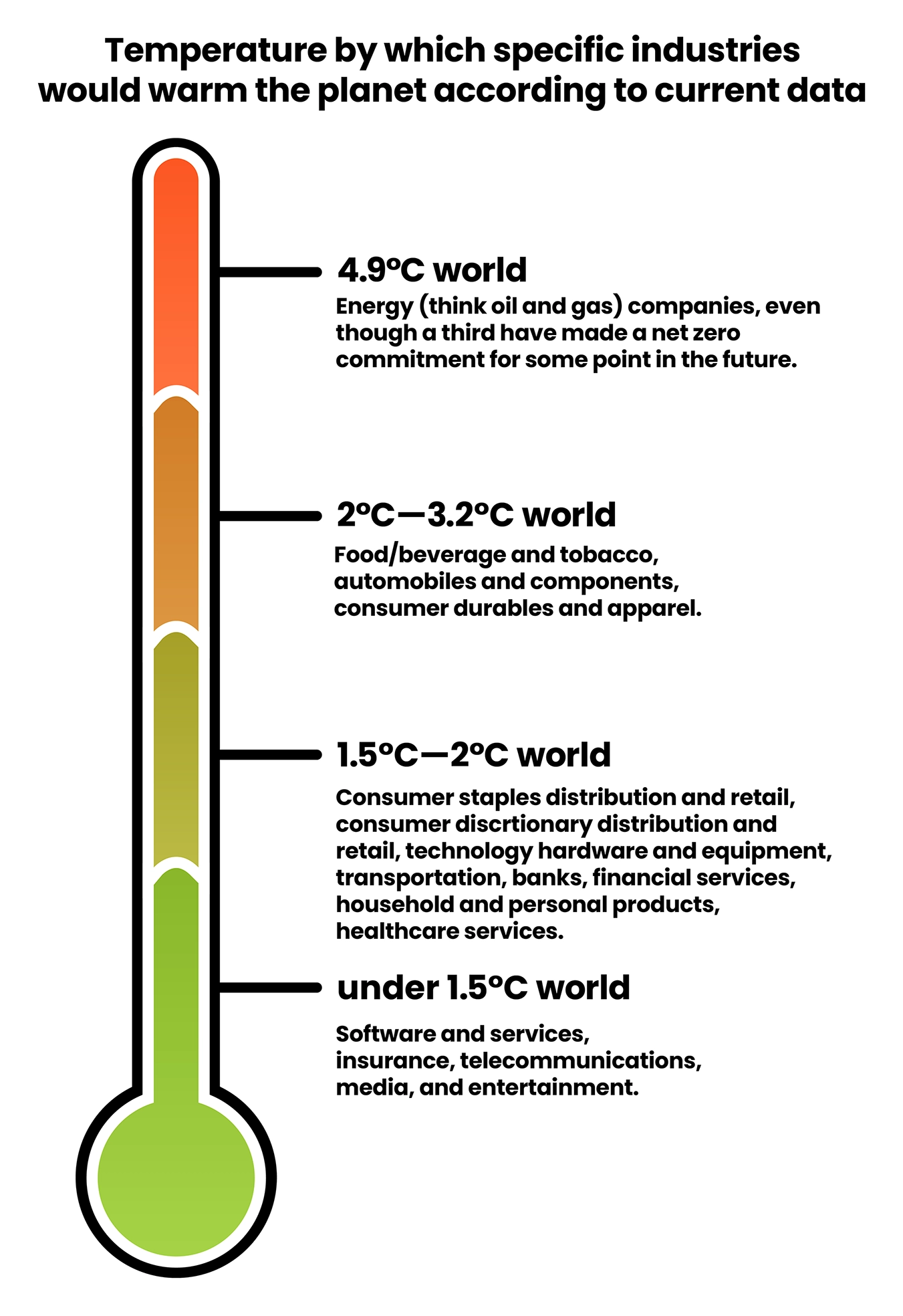
Commitments and even reductions in emissions intensity are a great start but they do not translate to being on track with a 1.5°C world.
Many pledges are relatively recent and may not be supported by comprehensive action plans with reporting on progress against targets yet.
As is only natural, many companies start with low hanging fruit (like switching to renewable energy), easy to implement changes, cost saving changes and changes that have an obvious marketing advantage, leaving more complex problems and harder to abate emissions to follow.

Some good intentions will have false starts and failures (e.g. Lego8). Some mitigation efforts, though well-intended, suggest to consumers that more progress is being made than is actually happening (unintentional greenwashing).
Some companies intentionally greenwash and misrepresent their actions. Sometimes, as a consumer, it’s hard to tell the difference. There is also the issue of inflating progress with carbon offsets, well-intentioned or not9 and reliance on unproven or yet to be developed technologies to reach goals (such as Carbon capture and storage or CCS.)
The result is that it is difficult and, in many cases, too early to tell which companies are truly making concrete and substantial progress and which ones will succeed, though it is often easy to find genuinely positive actions and initiatives within companies and pick out companies that are genuinely committed to a 1.5°C world (see more below.)
In the next few years, we will see who emerges as successful in their efforts to deeply decarbonize in line with a 1.5°C goal.
Companies that are in a good position to demonstrate that they are truly on board with the transition and are mitigating climate change:

• Measure and disclose their Carbon Footprint

• Have goals that include near term/interim reduction targets (<= 2030) (vs. a simple future Net Zero 2050 pledge)

• Include Scope 3 emissions (supply chain and/or end use) where that is a relevant part of their footprint

• Outline detailed plans describing how they will reduce their carbon emissions and report on actions taken and progress towards goals

• Do not simply use carbon offsets in their plans or claims of carbon neutrality

• Do not rely on future, undeveloped, and unavailable solutions for success

• Report on their progress transparently and with third party verification
Look for these elements if you are evaluating companies for climate action.
• You can monitor progress of companies participating in the Science-Based Targets Initiative (as of the end of 2022) for example, here.
• Check out the Carbon Disclosure Project A (CDP A) list of companies here.
• Check out the Corporate Climate Responsibility Monitor 2023 here.
• See companies that are switching to renewable energy through the clean energy buyer’s alliance here.
• And peruse the progress of the largest Canadian TSX listed companies here.
I’ve also included review articles that describe some company initiatives and commitments at the bottom of this webpage.
Without deep and drastic cuts to emissions, in the near term, we are not likely to meet a 2°C limit let alone the 1.5°C goal. That’s why it is so important that individuals step up to support decarbonization initiatives of companies (including the ones they work for!) and/or decarbonize their own consumption.
It is also critically important to support governments that help and reward businesses that decarbonize, punish those that don’t, and keep all businesses accountable to both self-declared and legislated commitments.
The best thing you can do is replace any excess consumption of conventional goods with consumption of low carbon experiences, use circular practices, and buy sustainable versions of products that:

are circular in some ways, and/or…

do not use fossil fuels

are energy efficient

have little to no packaging

have little to no plastic

were created with renewable energy sources

last, and are kept for, a long time.
The future is not written, and the faster and more drastically we can tweak our lives to respond to this crisis the better off we will be.
Back to the nitty gritty — when buying new stuff
Do a browser search for sustainable or carbon-neutral brands for what you are looking for in advance and try to familiarize yourself with key criteria for carbon neutrality.
Are the materials plastic, steel or concrete or made with sustainable wood products, sustainable fabrics (see fashion section) etc.? Do the items have energy efficiency ratings, if applicable? Is there evidence of participation in a Net Zero or similar alliance (see above)?
Can you find a sustainability page/report with a carbon reduction commitment supported by a detailed plan and evidence of progress (ideally, more than carbon offsets)?
Before you buy from your ‘go to’ brands, try to take a minute to evaluate them from a sustainability perspective. If they aren’t on board with the energy transition yet, try another brand that is and write to your ‘go to’ brands to let them know this is important to you.
You won’t be able to change all the buying habits you may need to at once and that’s ok. Just be conscious (but don’t feel guilty) when you are not considering sustainability and try to prioritize it the next time.
The exception to this is for bigger purchases with long-term commitments (particularly where there is ongoing energy consumption). If you are committing for a longer-term, it is important that you consider sustainability, energy efficiency and fossil fuel use before you buy.
These companies have either already made good and comprehensive strides or have near term targets for significant and credible progress that we can monitor over the next couple of years
Danone — Net Zero 2050 commitment with science based targets. Interim 2030 reduction goals (from 2020 baseline): to reduce Scope 1 and 2 emissions by 47.2%, reduce Scope 3 emissions (upstream and downstream) by 42%, reduce absolute Scope 1 and 3 forest, land, and agriculture emissions by 30.3% and more. In 2023, committed a 30% reduction in methane reduction from fresh milk by 2030 (aligned to the Global Methane Pledge.)
Nestle — Committed to 20% emissions reduction by 2025, 50% reduction by 2030, Net Zero by 2050 at the latest. Include Scope 3 supply chains in Net Zero roadmap. Aim to source 50% of key ingredients through Regenerative Agriculture methods by 2030. Will invest in sustainable logistic, packaging and manufacturing. Also committed to carbon removals through restoration of forests, wetlands and peatlands (carbon sinks.)
Coca-Cola, HBC (a subsidiary of Coca-Cola and major regional bottling partner) — Science-based target to reduce emissions 25% by 2030 and commitment to Net Zero across entire value chain by 2040 including Scope 3 emissions from its suppliers. Will use 100% renewable electricity and low carbon energy sources in its operations, cut emissions from agricultural ingredients, embrace circular economy principles and implement a green fleet program.
Nike — Launched a Move to Zero initiative with a goal of 30% emissions reduction across supply chain by 2030. Nike Air products contain at least 50% recycled materials and >75% contain some recycled materials. 99.9% of footwear manufacturing waste is converted into energy. North American operations are powered on 100% renewable energy (intend to extend across globe by 2025.) Nike Grind recycling program — used footwear and surplus manufacturing materials are transformed into new shoes and apparel, running tracks, basketball courts, outdoor play equipment etc.
Unilever (e.g. Ben & Jerry’s, Breyers, Dove, Lipton etc.) — 26 brands are sourced from 100% sustainable materials, goal to become carbon negative by 2030, adopted a sustainable agriculture code in 2018 for sourcing raw materials from sustainable suppliers. Has reduced its CO2 emissions by 65% and total waste by 96% in 2023 (vs 2008), industry leader in reusable and recyclable packaging via partnership with Loop (where single-use products are sold in refillable glass and stainless steel packaging.)
Johnson and Johnson (e.g. Johnson’s, Neutrogena, Aveeno) — Received Energy Star Partner of the Year Award in 2019, joined the steering committee of CEBA (see above), is on the CDP A List (see above), Measures the impact of ingredients on aquatic life, partnered with the C40 Cities Climate leadership group on 26 projects, robust recycling program, 139 consumer, medical device and pharmaceutical products awarded an ‘Earthwards’ designation for integrating sustainable design solutions to reduce waste and energy use, Contact lens recycling program in the UK.
IKEA — Committed to reductions aligned with a 1.5°C target and aim to halve emissions by 2030. Have completed in depth assessment of their Carbon Footprint and have a plan to tackle major contributing components. E.g. aim to reach 100% renewable or recycled materials by 2030. Aim to reach100% renewable electricity for all IKEA operations by 2030 and enable supply partners to reach this goal as well. Reached 100% renewable electricity in retail and centre operations across 23 countries in 2021. Create products that save energy at home, have more plant-based food options, aim to become a circular business by design by 2030.
Microsoft — Intends to use 100% renewable energy by 2025 and become carbon negative by 2030. By 2050 it hopes to have removed all of the carbon it put into the atmosphere since its founding in 1975. Also focusing on tech solutions to help other companies decarbonize.
Also see our Your Clothes page for more.
Sustainable cleaning and self-care:
note: if you use cleaning services — ask if they use eco-friendly products and/or request that they use yours.
Here are a few additional self-care/beauty product links.
Canadian businesses taking action may also be members of the Clean Economy Canada network.
Other ways you can take action
Write to your go to brands, stores, influencers, magazines and other consumer goods sources and ask them about their thoughts/stances/policies/plans/targets around sustainability and climate action. Ask them to carry sustainable products. Ask them to include sustainability and ethics in their ratings criteria and recommendations.

Advocate for transparency around climate targets and actual emissions for big brands.

Advocate for legislation against greenwashing.

Sign petitions related to corporate climate action, greenwashing and plastic pollution.

Share information with friends and family.

Encourage others to bring circular economy principles into their lives and shop sustainably.

Most importantly—when it comes to consumption—less is best.
References
1. Lang, T., Li, G., & Mattie, S. (2022, March 28). Data for Canadian Greenhouse Gas (GHG) emissions attributable to household consumption and use of select goods and services along with the associated emissions intensity figures and breakdowns by final demand categories. Government of Canada, Statistics Canada. https://www150.statcan.gc.ca/n1/pub/11-627-m/11-627-m2022003-eng.htm
2. Government of Canada. (2021, July 30). Greenhouse gas emissions performance for the 2019 model year light-duty vehicle fleet. Canada.ca. https://www.canada.ca/en/environment-climate-change/services/canadian-environmental-protection-act-registry/greenhouse-gas-emissions-performance-2019.html#tab2
3. Environment and Climate Change Canada. (2022). 2030 Emissions Reduction Plan — Canada’s Next Steps for Clean Air and a Strong Economy. https://publications.gc.ca/collections/collection_2022/eccc/En4-460-2022-eng.pdf
4. MSCI Sustainability Institute. (2023). The MSCI Net-Zero tracker. https://www.msci.com/documents/1296102/41874802/NetZero-Tracker-NOV-cbr-en.pdf/e03b09df-911a-143c-bdda-36fd572a8972?t=1699917087121
5. Accenture. (2023b). Destination Net Zero — Tracking global progress on the targets and actions companies are taking to accelerate their journey to Net Zero. https://www.accenture.com/content/dam/accenture/final/accenture-com/document-2/Destination-Net-Zero-2023-Report.pdf
6. Corporate sustainability reporting directive. European Commission. (2023, December 22). https://finance.ec.europa.eu/regulation-and-supervision/financial-services-legislation/implementing-and-delegated-acts/corporate-sustainability-reporting-directive_en; SEC Proposes Rules to Enhance and Standardize Climate-Related Disclosures for Investors. U.S. Securities and Exchanged Commission. (2022, March 21). https://www.sec.gov/news/press-release/2022-46; Climate Risk Management. Office of the Superintendent of Financial Institutions. (2023, April 26). https://www.osfi-bsif.gc.ca/Eng/fi-if/rg-ro/gdn-ort/gl-ld/Pages/b15-dft.aspx
7. Greenifs. (2023, May 16). greenwashing regulations around the world. LinkedIn. https://www.linkedin.com/pulse/greenwashing-regulations-around-world-greenifs/
8. Euronews Green & AP. (2023, September 15). Lego’s quest to make recycled plastic bricks has failed. Now the toymaker is turning to e-methanol. https://www.euronews.com/green/2023/09/25/legos-quest-to-make-recycled-plastic-bricks-has-failed-now-the-toymaker-is-turning-to-e-me#:~:text=After%20two%20years%20of%20testing,lead%20to%20higher%20carbon%20emissions
9. Naik, G., & White, N. (2023, August 24). Junk offsets are feeding mass wave of greenwashing, study shows. https://www.bnnbloomberg.ca/junk-offsets-are-feeding-mass-wave-of-greenwashing-study-shows-1.1963197; Chasing carbon unicorns: The deception of carbon markets and “net zero.” Friends of the Earth International. (2022, July 18). https://www.foei.org/publication/chasing-unicorns-carbon-markets-net-zero/

